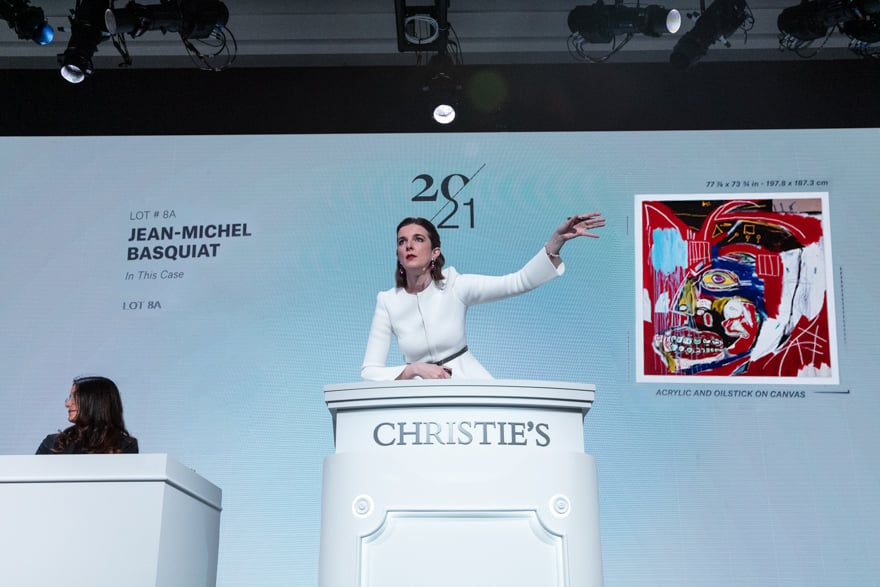
Christie’s pulled out all the stops today, July 13, with a high-profile line-up of far-flung executives for a virtual call to announce the results of its wide-ranging business activities in the first half of 2021.
The total sales for the first six months of the year amounted to $3.5 billion, making it the auction house’s second-best half-year total in the past six years, and exceeding the 2019 equivalent by 13 percent.
Executives noted the significance of an influx of buyers and intense demand from Asia (which accounted for 39 percent of the value of auction sales worldwide), as well as the auction house’s plunge into sales of non-fungible tokens (NFTs) this year. They also highlighted how a recent spate of marathon hybrid sales have helped provide solutions for challenges ranging from Brexit to international coronavirus restrictions.
“After a year of COVID-related disruption and change, Christie’s strong results in the first half of 2021 show the resilience of the art market and Christie’s ability to adapt and to innovate in a challenging context,” CEO Guillaume Cerutti said on the call.
Auctioneer Adrien Meyer fields bids during Christie’s 20th Century evening sale in New York in May 2021. Photo: Christie’s Images Ltd. 2021.
The house said private sales for the first half were just north of $850 million, an increase of 41 percent as compared with 2020, with a 30 percent increase in private sales of works above $5 million as compared with first half of 2020.
Global head of private sales Adrien Meyer said the strength was somewhat surprising given that the strong uptick last year—238 percent over first half of 2019—was clearly connected with the lack of physical auctions.
“It’s quite reassuring that the trend has continued as auctions have picked up,” he noted.
Asia has played a major role in the robust performance, as reflected by the reported $1.04 billion “in live and online purchases” made in the first half, which Christie’s said is the highest spending from the region in at least five years. And Hong Kong auctions at Christie’s Asia for the first six months achieved $495 million, up 40 percent over the first half of 2019.
Christie’s also reported a total of about $93 million in NFT sales, while conceding that the lion’s share, $69 million, was paid for the offering of Beeple’s The First 5,000 Days in March.
Beeple, Everydays – The First 5000 Days NFT, 21,069 pixels x 21,069 pixels (316,939,910 bytes). Image courtesy the artist and Christie’s.
Asked about where NFT buyers are emerging from, Marcus Fox, global managing director of postwar and contemporary art, said the Beeple auction “brought over 400 new clients to Christie’s from a wide cross-section of the globe,” he said, citing bidders from Asia, Europe, and the U.S.
While subsequent NFT sales have varied as far as participation rates, Fox said, they have tended to draw more new than existing clients, but with a similar geographic breakdown: a third each from Asia, the Americas, and Europe.
Christie’s COO Ben Gore added that roughly 85 percent of the payments for the NFT totals had come in the form of cryptocurrency. Christie’s initially began by accepting Ethereum at the time it offered the Beeple work, but is now accepting Bitcoin for some lots.
“We are, to a degree, directed by our clients,” he said. “Whether they wish to accept crypto will influence how [we] think about bringing this form of payment into the rest of our business.”
Even as executives talk about a return to IRL auction salerooms, they praised the flexibility of the hybrid auction model. Christie’s vice chairman Giovanna Bertazzoni noted that it allowed the auction house to place a major Ernst Ludwig Kirchner painting in the Paris leg of a marathon sale that would otherwise have never made it to London because of Brexit restrictions.
Further, specialists from countries such as Italy who could not go to London because of COVID restrictions could still get to Paris and bid on behalf of their clients there.
“This collaboration with Paris and all the fluidity with the other selling sites in Europe has been vital for us gathering and selling the sales throughout the first six months,” Bertazzoni added.